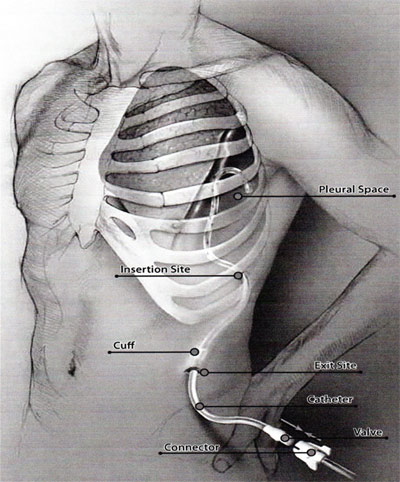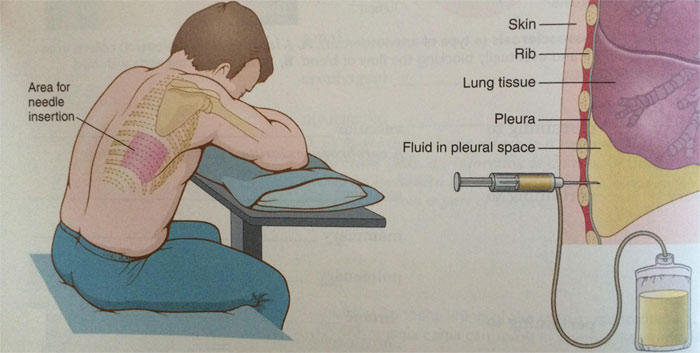Pulmonary Thoracentesis
How is the Pulmonary Thoracentesis Test Performed?
The Test is Done in the Following Way:
- You sit on a bed or on the edge of a chair or bed. Your head and arms rest on a table.
- The skin around the procedure site is cleaned. A local numbing medicine (anesthetic) is injected into the skin.
- A needle is placed through the skin and muscles of the chest wall into the space around the lungs, called the pleural space.
- Fluid is drawn out with the needle.
- The fluid may be sent to a laboratory for testing (Pleural Fluid Analysis).
How do I to Prepare for the Test?
- No special preparation is needed before the test. A chest x-ray will probably be done before and after the test.
- Do not cough, breathe deeply, or move during the test to avoid injury to the lung.


How the Test will Feel?
- You will feel a stinging sensation when the local anesthetic is injected. You may feel minor pain or pressure when the needle is inserted into the pleural space.
- Tell your health care provider if you feel short of breath or have chest pain.
Why the Test is Performed?
- Normally, very little fluid is in the pleural space. A buildup of too much fluid between the layers of the pleura is called a pleural effusion.
- The test is performed to determine the cause of the extra fluid, or to relieve symptoms from the fluid buildup.
The Test may also be Performed for the Following Conditions:
- Asbestos-Related Pleural Effusion
- Collagen Vascular Disease
- Drug Reactions
- Hemothorax
- Lung Cancer
- Pancreatitis
- Pneumonia
- Pulmonary Embolism
- Pulmonary Veno-Occlusive Disease
- Thyroid Disease
- Normal Results
- Normally the Pleural Cavity contains only a very small amount of fluid.
What do Abnormal Results Indicate?
Testing the fluid will help your health care provider determine the cause of pleural effusion. Possible causes may include:- Cancer
- Cirrhosis
- Heart failure
- Infection
- Inflammation
- Malnutrition
- Kidney disease
If your health care provider suspects that you have an infection, a culture of the fluid may be done to test for bacteria.
Risks
Risks can Include any of the Following:
- Bleeding
- Infection
- Pneumothorax
- Respiratory Distress
- Considerations
A chest x-ray is done after the procedure to detect possible complications.
Alternative Names:
- Pleural Fluid Aspiration
- Pleural Tap
